Churchstoke is a village and community situated in Montgomeryshire, about nine miles east of Newtown, just inside the border with England. The county town, Montgomery, is about three miles north-west of the village. The community of Churchstoke includes the neighbouring villages of Hyssington and The Marsh. The men of Churchstoke who fell during both World Wars are commemorated on the Churchstoke War Memorial, which is situated within St. Nicholas’ Churchyard. The memorial takes the form of a Latin Cross, upon the base of which are engraved the names of the fallen. The memorial was unveiled on 1 August 1920, in the presence of the Earl of Powis. I have taken the liberty of adding the details of several men with ties to Churchstoke who are not named on the memorial.
The Great War, 1914-1918
Harold Banks, Private, 10573, East Lancashire Regiment. Harold was born in Manchester in 1895. He was fostered by Mrs Elizabeth Simpson, and was raised by her at Birkenhead and then at The View, Old Churchstoke. Harold was living at Sunderland prior to the war, and enlisted there into the East Lancashire Regiment. On 22 April 1915 he embarked for France, joining the 2nd Battalion, East Lancashire Regiment, which was attached to 24 Brigade, 8th Division. Harold was among 55 reinforcements who joined the battalion in billets at Bac St. Maur on 24 April, following heavy losses at Neuve Chapelle, and later that day, the battalion moved into the front line to begin a routine tour. On 27 April the battalion was relieved, and moved into billets at Rue De Bois, then two days later the battalion began another spell in the front line at Rue Petillon. The battalion was again relieved on 3 May, and enjoyed three days in billets before moving back into the front line on 7 May, preparatory to the opening of the Battle of Aubers Ridge. At dawn on 9 May 1915, the 2nd East Lancs launched an assault against the German line running from Points 884 to 375, but the Germans opened up a murderous hail of machine-gun fore onto them, and over 400 casualties were suffered by the battalion alone. Harold was 19-years-old when he was killed that day. He has no known grave and is commemorated on the Ploegsteert Memorial, Belgium. Harold is not commemorated on the Churchstoke war memorial.
John Walter Corfield, Private, 355097, Royal Welsh Fusiliers. John was the eldest of two sons of Jane Lewis (nee Corfield), of Green Lane, Churchstoke. He worked as a farm labourer at Trefin, Sarn, and had enlisted into the Montgomeryshire Yeomanry at Newtown on 26 March 1913. John had attended two annual summer camps prior to the outbreak of war. On 5 August 1914 the Montgomeryshire Yeomanry was mobilised at Welshpool, as part of the South Wales Mounted Brigade, before moving via Hereford to Thetford, to join the 1st Mounted Division. On 4 March 1916 the 1st Mounted Division sailed for Egypt to join the EEF. On 4 March 1917 the battalion merged with the Welsh Horse Yeomanry to form the 25th (Montgomery & Welsh Horse Yeomanry) Battalion, Royal Welsh Fusiliers, as part of the newly formed 231 Brigade, 74th (Yeomanry) Division. The Division assembled in Egypt as part of the EEF, before crossing the Suez Canal into the Sinai, and saw its first major action during the Second Battle of Gaza. The battle was a failure, and the EEF was re-organised under a new commander, Sir Edmund Allenby, before launching the Third Battle of Gaza on the night of 31 October 1917. This assault was launched along a winder front, running from Gaza to Beersheba, and this time the EEF prevailed, opening the door to Jerusalem. John was killed in action during the initial assault on 31 October 1917. The 22-year-old has no known grave and is commemorated on the Jerusalem Memorial, Israel.
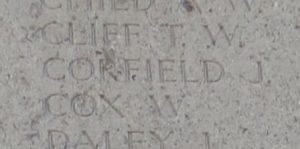
Denis Davies, Private, 2752, South Staffordshire Regiment. Denis was the son of Thomas and Susan Davies, of Upper Aldress, Churchstoke. He worked as a schoolteacher, and lived at 9 The Parade, Dudley, Worcestershire prior to the war. Denis enlisted into the 1/6th Battalion, South Staffordshire Regiment at Wolverhampton soon after the outbreak of war. The battalion was a Territorial Army unit, which mobilised at the Drill Hall, Wolverhampton on 4 August 1914, as part of the Staffordshire Brigade, North Midland Division. On 3 March 1915 the battalion embarked for France with the division, and in May its formation became renumbered to 137 Brigade, 46th (North Midland) Division. The Division moved to Egypt in January 1916, but the following month returned to France, taking over the Gommecourt Sector. On 1 July 1916 the Division took part in a diversionary attack in the Gommecourt Salient, to divert German attention away from the main assault just to the south, during the opening of the Battle of the Somme. Denis appears to have been wounded and taken prisoner during his battalions’ assault, and died of his wounds in captivity on 3 July 1916, aged 39. He is buried in Ervillers Military Cemetery, France.
George Davies, Sergeant, 9329, Royal Welsh Fusiliers. George was the son of John and Charlotte Davies, of Brompton Smithy, Churchstoke. He worked as a Labourer prior to enlisting into the Royal Welsh Fusiliers at Wrexham on 15 January 1907 and over the coming years had served with both the 1st and 2nd Battalions of the regiment, before leaving the army and joining the Army Reserve on 9 February 1914. Following the outbreak of war, he was mobilised and re-joined the 1st Battalion, Royal Welsh Fusiliers, being appointed Sergeant. The battalion had sailed back to England from Malta on 3 September 1914, and George joined the battalion at Lyndhurst, where it was attached to 22 Brigade, 7th Division. On 7 October 1914 the Division landed at Zeebrugge, but by then the city was under siege by the Germans, so the Division moved to Ypres, becoming the first British Division to hold the city. The Division then fought during the First Battle of Ypres, where it helped stop the German advance through Belgium. During March 1915 the Division fought at the Battle of Neuve Chapelle, and then on 15 May 1915 saw further heavy fighting at the Battle of Aubers Ridge, and at the Battle of Festubert. By 18 July 1915 the 1st RWF had moved into rest billets at Vielle-Chapelle, where news was received of gallantry awards to a number of officers and men of the battalion, including the award of the Victoria Cross to Fred Barter. George had been posted as missing during the Battle of Festubert on 16 May 1915. Oddly the official date of his death is 24 July 1915. The 27-year-old has no known grave, and is commemorated on the Le Touret Memorial, Richebourg-L’avoue, France, although his service papers state that his body was recovered on 8 August and buried, so there are several mysteries surrounding his death. His battalion suffered 559 casualties at Aubers Ridge and Festubert, so some chaos regarding the recording of casualties is probably to be expected.
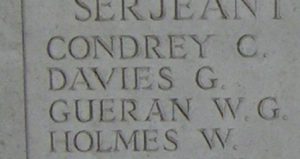
Thomas Ernest Davies, Private, 55329, Royal Welsh Fusiliers. Thomas was the son of Thomas and Martha Mary Davies, of Pentre, Church Stoke. He originally enlisted into a Territorial battalion of the Royal Welsh Fusiliers at Welshpool, and after completing his training, was posted to France in the autumn of 1916, joining the 14th Battalion, Royal Welsh Fusiliers, which was attached to 113 Brigade, 38th (Welsh) Division. The Division was by then in the Canal Bank sector at Boesinghe, north of Ypres, where it had been sent following heavy losses during its capture of Mametz Wood in July 1916. The infantry battalions of the Division then began carrying out the normal pattern of rotation in the trenches, four days in the front, four in support and four in reserve, whilst also working on trench improvement, digging new trenches, and also carrying out regular patrols and trench raids. On the night of 17/18 February 1917, the battalion sent out a trench raiding party under the command of Lieutenant H. S. Ormsby. The party, three officers and 122 men, entered the German front line trenches but came under heavy fire from German trench mortars and artillery, suffering heavily before being forced to withdraw. Fifteen men were killed and twenty-five had been wounded during the raid. Thomas was initially among eleven men posted as missing, believed killed during the raid. He was later accepted to have been killed in action during the early hours of 18 February 1917, aged 20. He was originally buried in Langemarck Pilckem German Cemetery, but during further fighting in the area, the graves within the cemetery were lost, so Thomas is now commemorated on a Special ‘Kipling’ Memorial in Poelcapelle British Cemetery, Belgium.
John Glyn Evans, Lance Corporal, 55200, Royal Welsh Fusiliers. John was the son of John and Clara Evans, of Argoed, Churchstoke. He enlisted at Welshpool into the Montgomeryshire Yeomanry soon after the outbreak of war, and was sent to Park Hall Camp, Oswestry for training. John was drafted to France early in 1917, joining the 2nd Battalion, Royal Welsh Fusiliers, which was attached to 19 Brigade, 33rd Division. John probably joined the battalion at Arras, where it was to see terrible fighting with the Division on the Hindenburg Line during the Battle of the Scarpe and the Battle of Bullecourt. At the end of June 1917, the Division was relieved and moved into rest billets in the Airaines area, spending most of July training before moving to positions at Bray Dunes at the end of July, to prepare for a possible assault along the Flanders Coast. The intention was for the advance here to take place if the Allies broke through during the Passchendaele offensive, but when the latter offensive became bogged down, the 33rd Division was transferred to the Ypres Salient in the middle of September, and joined the fight for Passchendaele Ridge. By 26 September the Division had moved into positions facing Polygon Wood, and saw terrible fighting there over the coming days. Over the coming weeks the 2nd RWF rotated between front line, reserve and support, as was the norm, and by 24 November had moved back into the front line to begin another spell in the trenches on Passchendaele Ridge. John was killed in action when the front-line trenches were hit by German artillery fire on the following day, 25 November 1917.The 20-year-old has no known grave and is commemorated on the Tyne Cot Memorial, Belgium.
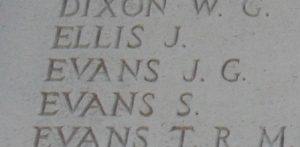
William Charles Evans, Private, 2627, Montgomeryshire Yeomanry. William was the son of William and Catherine Evans, of Fir Court, Churchstoke. He enlisted into the Montgomeryshire Yeomanry on 29 September 1914, and was posted to Park Hall Camp, Oswestry for training. Whilst at Oswestry his health broke down, and William was diagnosed as having contracted tuberculosis. He was discharged as medically unfit on 14 May 1915 and returned to Churchstoke, but by 1919 had died of tuberculosis. Nothing further is known of him, as he is not commemorated by the CWGC. William is not commemorated on the Churchstoke war memorial.
William Heath Evans, Gunner, 206657, Royal Field Artillery. William was the son of Albert and Mary Jane Evans, of Llanerch, Churchstoke. He enlisted into the Royal Field Artillery at Welshpool, and was posted to the 70th Battery, 34th Brigade, Royal Field Artillery. He probably joined the battery in France early in 1917, and would have taken part in the Passchendaele offensive later that year. Unfortunately, the war diary for the Brigade for 1918 does not appear to exist, but the Brigade was in the Arras sector over the summer of 1918, preparing to take part in the launch of the great Allied offensive on 21 August. William was killed in action on the opening day, probably by counter-battery fire, on 21 August 1918. The 20-year-old is buried in Berles New Military Cemetery, France.
John Fletcher, Private, 50390, Machine Gun Corps. John was born in Ellesmere in 1886, the son of William and Jane Fletcher. The family then resided at Whitchurch, Shropshire, before moving to Broadway, Churchstoke by 1911. John worked as a Joiner prior to the war. He was among the first local men to enlist into the army, enlisting with his twin brother, William, into the 7th Battalion, Royal Welsh Fusiliers at Welshpool in August 1914. The battalion was a Territorial unit, which mobilised for war at Newtown in August 1914, as part of North Wales Brigade, Welsh Division and moved to Conway until the end of the month, before moving to Northampton. In December the Division moved to Cambridge and then in May 1915 to Bedford, where the Division was numbered and the formation became 158 Brigade, 53rd (Welsh) Division. On 19 July 1915 the entire Division sailed from Devonport for Imbros and on 9 August 1915 landed at Suvla Bay. The infantry moved off the beaches into the bush, but due to a lack of maps and no knowledge of the terrain, many of the units became disorientated, and the situation became chaotic. The Division was eventually evacuated from Gallipoli in December 1915, moving to Egypt to join the EEF, and helped guard the Suez Canal before taking part in operations to drive the Turks out of the Sinai. By now, John had been transferred to the 158th Company, Machine Gun Corps, which was attached to the same 158 Brigade, 53rd (Welsh) Division. The EEF then turned its attention onto driving the Turks out of Palestine, and on 26 March 1917 launched its first offensive against the coastal city of Gaza, which guarded the road to Jerusalem. Initial gains during the day were lost when the assaulting divisions lost touch with each other and communication broke down when a thick fog cloaked the battlefield. John was killed in action at Gaza on 27 March 1917, aged 31. He has no known grave and is commemorated on the Jerusalem Memorial, Israel.
Francis John Ford, Private, 10629, South Wales Borderers. Francis was the son of Edward and Emma Ford, of School House, Mellington, Churchstoke. He enlisted into the South Wales Borderers prior to 1911, and by then was based at the Depot, in Brecon. Francis then served with the 2nd Battalion, South Wales Borderers, which was based in Tientsin, China at the outbreak of war. On 23 September 1914, the battalion took part in an operation in conjunction with the Japanese against the German held garrison at Tsingtao soon after the outbreak of war, before embarking at Hong Kong on 4 December, returning to England and landed at Plymouth on 12 January 1915. The battalion then entrained for Rugby, joining 87 Brigade, 29th Division, and on 17 March 1915 the Division sailed from Avonmouth, arriving at Alexandria on 29 March. By 11 April the Division had sailed to Mudros Island aboard HMS Cornwallis, then at dawn on 25 April 1915 took part in the landings on the Gallipoli Peninsula, landing on separate beaches at Morto Bay, and became caught up in desperate fighting around De Tott’s Battery over the coming days. On 28 June 1915 the Division launched a frontal assault against Boomerang Trench. The 2nd SWB was in support of the Border Regiment, advancing though a hail of shrapnel, but managed to capture a section of Turkish trench-line. Francis was killed in action at some time during the day. The 24-year-old has no known grave and is commemorated on the Helles Memorial, Gallipoli.
Arthur Gardner, Private, 54722, Royal Welsh Fusiliers. Arthur was the son of William and Mary Gardner, of Brynkin Green, Churchstoke. He worked as a farm labourer prior to enlisting into the Royal Welsh Fusiliers, and after completing his training, was posted to France in the summer of 1916, joining the 10th Battalion, Royal Welsh Fusiliers, which was attached to 76 Brigade, 3rd Division. He would have joined the 10th RWF among a draft of reinforcements following its ordeals at Delville Wood in July 1916, and would have seen his first major action during the battalion’s assault on Serre on 13 November. In May 1917 the Division was at Arras, and fought at the First and Second Battles of the Scarpe, and at the Battle of Arleux and the Third Battle of the Scarpe, where it captured Roeux. By now Arthur’s health had broken down, and he was diagnosed as suffering from pulmonary tuberculosis and kyphosis of his spine. Arthur was discharged from the army as medically unfit on 14 September 1917, and returned home to Churchstoke, where he died of tuberculosis on 18 September 1921, aged 30. Arthur is not commemorated by the CWGC, and is not commemorated on the Churchstoke war memorial. His brother, John, had been killed in 1918.
John Francis Gardner, Private, 30648, Border Regiment. John was the son of William and Mary Gardner, of Brynkin Green, Churchstoke. He worked as a cowman prior to enlisting at Wrexham into the 3rd Cyclist Regiment on 22 February 1917. On 28 September 1917 John embarked for France, and joined No 5 Infantry Base Depot, at Étaples. On 28 September 1917 he was posted to the 13th Battalion, Royal Welsh Fusiliers, but was then diverted to the 10th Battalion, Royal Welsh Fusiliers, which was attached to 76 Brigade, 3rd Division and had suffered heavy casualties at Passchendaele, joining the battalion in reserve at Barastre on 9 October. On 20 October the battalion moved back into the line at Bullecourt to begin a routine tour and remained in this sector over the winter. On 8 February 1918 the 10th RWF was disbanded and on 6 April 1918 John was transferred to the 7th Battalion, Border Regiment, which was attached to 51 Brigade, 17th (Northern) Division. The Division had suffered terrible casualties when it was hit hard by the Germans near Hermies following the launch of their Spring Offensive on 21 March 1918, and the 7th Border’s had suffered around 250 casualties. The Division then moved to the Acheux sector to rest and rebuild, holding a relatively peaceful sector of the line. John was killed in action during a German trench-mortar bombardment on 2 June 1918. The 19-year-old is buried in Acheux British Cemetery, France. His brother, Arthur, died of tuberculosis, which had been brought on by his service, in 1921.
Thomas Reuben Hannum, Gunner, 220585, Royal Field Artillery. Thomas was the son of John and Ann Hannum, of Pound Bank, Churchstoke. He married Mary Elizabeth Trow, a Parlour Maid of Garthmyl Hall, in 1917, and the couple briefly lived at Green Bungalow, Churchstoke. Thomas enlisted into the Royal Field Artillery at Newtown, and was posted to France, joining A Battery, 330th Brigade, Royal Field Artillery. The Battery was attached to the 66th (East Lancs) Division, and had landed in France on 26 February 1917. The Division concentrated by 16 March 1917 and moved to the Flanders Coast, in readiness for a planned offensive, but during the meantime the Passchendaele offensive had become bogged down, so at the end of September 1917 the Division moved to Ypres, and took part in the Battle of Poelcapelle. Over the winter the Division remained in the Ypres Salient, but in February 1918 moved south to the Somme, to positions near Moreuil, and on 21 March 1918 was hit hard when the Germans launched the opening phase of their Spring Offensive. Several guns of the 330th Brigade were over-run, but their handlers managed to remove the breech blocks before being forced to withdraw. The situation was obviously dire, as the artillery-men reported that barely any infantry from the Division had been seen to retire, so it was obvious that heavy casualties had been suffered. Over the coming days the remnants of the Division withdrew under heavy pressure and by 26 March the Divisional Artillery had reached Guillacourt. Thomas was killed in action on the following day, 27 March 1918. The 27-year-old has no known grave and is commemorated on the Pozieres Memorial, France.
John Carter Jones, Armourer’s Crew, M/18938, Royal Navy. John was born on 11 July 1894, the son of Rees Carter Jones and Myfanwy Jones (nee Morris), of Cann Smithy, Churchstoke. He enlisted into the Royal Navy on 9 February 1916 and trained as an Armourer before being posted to HMS Excellent, the Naval Base at Portsmouth. John was then posted to the Royal Marine Howitzer Brigade, which was attached to the 63rd (Royal Naval) Division in France. The Division had moved to France in May 1916 and moved to positions on the Somme, where it took part in the Battle of the Ancre, and the resulting Operations on the Ancre. In April 1917 the Division was at Arras, and fought at the Second Battle of the Scarpe, where it captured Gavrelle. The Division then fought at the Battle of Arleux, before moving north to Ypres, where it took part in the Second Battle of Passchendaele. The Divisions next major action was at Cambrai, during the Action of Welch Ridge, and it was still in the area when the Germans launched their Spring Offensive of 21 March 1918, seeing heavy fighting as it withdrew over the coming days. By May the fighting had moved south, to the Aisne sector, and the 63rd Division enjoyed a relatively quiet few months holding the line in the Loos sector. John was killed in action near Loos on 25 June 1918, during this more peaceful period. The 23-year-old is buried in Mazingarbe Communal Cemetery Extension, France.
John Charles Jones, Private, 291291, Royal Welsh Fusiliers. John was born in Churchstoke, Montgomery, the son of Charles and Minnie Jones. By 1914 the family had moved to Hengar Cottage, Llanfachreth Road, Dolgellau. He enlisted at Welshpool into the 7th Battalion, Royal Welsh Fusiliers soon after the outbreak of war. The battalion was a Territorial unit, which mobilised for war at Newtown in August 1914, as part of North Wales Brigade, Welsh Division and moved to Conway until the end of the month, before moving to Northampton. In December the Division moved to Cambridge and then in May 1915 to Bedford, where the Division was numbered and the formation became 158 Brigade, 53rd (Welsh) Division. On 19 July 1915 the entire Division sailed from Devonport for Imbros and on 9 August 1915 landed at Suvla Bay. John joined up with the battalion in Egypt, following its evacuation from Gallipoli in December 1915. The Division had moved to Egypt to join the EEF, and helped guard the Suez Canal before taking part in operations to drive the Turks out of the Sinai. The EEF then turned its attention onto driving the Turks out of Palestine, and on 26 March 1917 launched its first offensive against the coastal city of Gaza, which guarded the road to Jerusalem. Initial gains during the day were lost when the assaulting divisions lost touch with each other and communication broke down when a thick fog cloaked the battlefield. John was killed in action during the days fighting. The 21-year-old has no known grave and is commemorated on the Jerusalem Memorial, Israel. His brother, Joseph, died the following year.
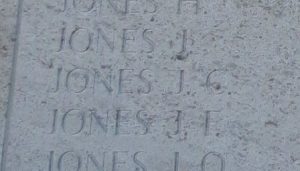
John R Jones. John cannot presently be identified.
Joseph Robert Jones, Shoeing Smith, 604284, Royal Horse Artillery. Joseph was born in Liverpool on 7 August 1895, the son of Charles and Minnie Jones. By 1914 the family had moved to Hengar Cottage, Llanfachreth Road, Dolgellau. Joseph served with the 2/1st (Shropshire) Brigade, Royal Horse Artillery, on home service, during the war. He was discharged as medically unfit in the summer of 1918 and died at home on 23 August 1918, aged 23. He is buried in St. Machraeth Churchyard, Llanfachreth. His brother, John, had been killed at Gaza the previous year.
Pryce Jones, Acting Bombardier, 51796, Royal Garrison Artillery. Pryce was the son of John and Harriet Jones, of Stone House, Churchstoke. He worked as a collier at Wattsville prior to the war. Pryce enlisted at Cardiff into the Royal Garrison Artillery on 16 November 1914, and was posted to the 131st Heavy Battery, RGA. On 8 March 1916 Pryce embarked with the battery at Southampton, and disembarked at Le Havre the following day and moved to positions near Arras. Pryce was wounded on 11 October 1916 and spent two days in hospital before re-joining the battery. The Battery moved to Kemmel in the summer of 1917, and supported the Battle of Messines Ridge on 7 June, before moving to Dranoutre. The battery then moved to positions near Vlamertinghe, to support the opening assault of the Third Battle of Ypres from 31 July onwards. On 1 August the battery sited its guns at Admirals Road, NE of Ypres, and from here spent the coming weeks engaged in counter-battery work, as well as supporting the attacking troops by responding to SOS signals. Pryce was wounded in the head here when the battery came under German artillery fire, and he was treated at Duhallow Farm Dressing Station, but died soon afterwards, on 15 August 1917. Pryce was 28-years-old, and is buried in New Irish Farm Cemetery, Belgium. Pryce is not commemorated on the Churchstoke war memorial.
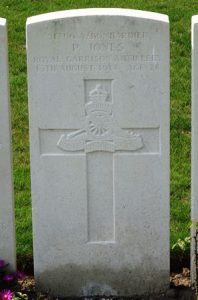
William Jones, Private, 10439, South Wales Borderers. William was the son of Anne Jones, of Lower Drifth, Churchstoke. His brother, Alfred, lived in Beguildy, where he worked as a farm hand. William was a regular soldier, and was serving with the 1st Battalion, South Wales Borderers at the outbreak of war. He disembarked in France on 9 November 1914 to join the battalion, which had been in France with the 1st Division since 13 August, and joined the battalion at Ypres, where it had been moved following the Battle of the Aisne. The task for the 1st Division at Ypres was a difficult one. The Germans plan, the Schlieffen Plan, involved a drive through Belgium to cut off the Channel ports, so the Allies had built a defensive line east of the city of Ypres, to stop this from happening. The division suffered heavy casualties at the fighting at Langemarck from 21-24 October, and the 1st SWB, together with the 2nd Welsh and 2nd Worcester’s, gained fame for holding the line at Gheluvelt following an overwhelming German attack on 31 October 1914. William joined the battalion at Outtersteene as part of a large number of drafts sent out to rebuild the battered battalion after its ordeals. He is officially recorded as being killed in action on 21 December 1914, although according to the battalion war diary, the battalion did not return to action until the following day, during an attack at Festubert. William has no known grave and is commemorated on the Le Touret Memorial, Richebourg-L’avoue, France. He is also commemorated on the Beguildy War Memorial.
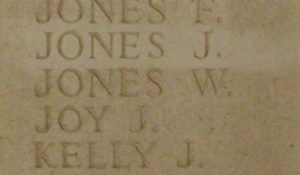
William Percy Jones, Sapper, 77107, Royal Engineers. William was the son of George Edward Jones and Martha Elizabeth Jones, of The Post Office, Hyssington, Churchstoke. He worked as a Post Office Clerk prior to the war. William enlisted at Welshpool into the Royal Engineers, and was posted to France, joining A Corps, HQ Signal Depot, Royal Engineers. William took ill whilst serving on the Western Front, and was taken to the 28th Stationary Hospital at Abbeville, where he died of disease on 12 May 1918, aged 23. He is buried in Abbeville Communal Cemetery Extension, France. William is not commemorated on the Churchstoke war memorial.
John Morgan. John cannot presently be identified.
John Lawton Owens, Corporal, 39046, South Wales Borderers. John was the son of David and Mary Jane Owens, of Cwmberllan, Sarn. He enlisted at Newtown into the 7th Battalion, Royal Welsh Fusiliers, and after completing his training was posted to France in the summer of 1917, where he was transferred to the 1st Battalion, South Wales Borderers. The battalion was attached to 3 Brigade, 1st Division, and John joined it at Coxyde, where the Division was preparing for a possible offensive along the Flanders coast. The Division remained here over the coming months, but when the Passchendaele offensive became bogged down, the coastal offensive was called off, and the 1st Division was transferred to the Ypres Salient in November. The Division took over positions to the south of the Houthulst Forest, and on 11 December the 1st SWB moved into the front line here for the first time, beginning a routine spell in the trenches. The men relieved the 1st Black Watch, and found that there was no trench-line, but merely a series of shell-holes, and conditions were abysmal. John was killed in action here on the following day, 12 December 1917. The 22-year-old has no known grave and is commemorated on the Tyne Cot Memorial, Belgium.
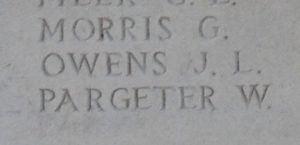
John Price. John cannot presently be identified.
John Ruscoe, Private, 41306, South Wales Borderers. John was the son of Richard and Eliza Ruscoe, of Brynkin Cottage, Churchstoke. He worked as a Waggoner prior to the war. John enlisted at Welshpool into the Royal Welsh Fusiliers, but after completing his training was drafted to France in the summer of 1917, where he was transferred to the 2nd Battalion, South Wales Borderers. The battalion was attached to 87 Brigade, 29th Division, and had suffered heavy casualties during the Passchendaele offensive. On 8 October 1917 the 2nd SWB was relieved from the front line at Ypres, and moved back to Poodle Camp at Proven. A week later the battalion entrained at Hopoutre, and moved with the division to the Beaumetz area, before marching to billets at Bellacourt, where the battalion rested and carried out a training scheme over the coming weeks. On 17 November the battalion marched to Boisleux and entrained for Péronne, before marching to a camp north of Haut Allaines, and during the evening marched to Fins, and then onto Gouzeaucourt. The Division had been ordered to carry out an assault at Marcoing, as part of the Battle of Cambrai. On 20 November the 2nd SWB launched their assault near Marcoing, towards Masnières, but were met with heavy fire. The battalion spent the night readying to attack Rumilly the following morning, and a squadron of tanks were called upon to aid their assault. Fighting raged over the coming days until the battalion was relieved on 23 November. John was wounded at some time during the assault on Masnières, and died of his wounds on 23 November 1917. The 30-year-old is buried in Rocquigny-Equancourt Road British Cemetery, Manancourt, France.
Thomas Pryce Ward, Second Lieutenant, South Wales Borderers. Thomas was the son of John Thomas and Catherine Ward, of Pentrehylig, Churchstoke. He originally enlisted into the 1/1st Battalion, Montgomeryshire Yeomanry. On 5 August 1914 the Montgomeryshire Yeomanry was mobilised at Welshpool, as part of the South Wales Mounted Brigade, before moving via Hereford to Thetford, to join the 1st Mounted Division. On 4 March 1916 the 1st Mounted Division sailed for Egypt to join the EEF. On 4 March 1917 the battalion merged with the Welsh Horse Yeomanry to form the 25th (Montgomery & Welsh Horse Yeomanry) Battalion, Royal Welsh Fusiliers, as part of the newly formed 231 Brigade, 74th (Yeomanry) Division. The Division assembled in Egypt as part of the EEF, before crossing the Suez Canal into the Sinai, and saw its first major action during the Second Battle of Gaza. The battle was a failure, and the EEF was re-organised under a new commander, Sir Edmund Allenby, before launching the Third Battle of Gaza on the night of 31 October 1917. This assault was launched along a winder front, running from Gaza to Beersheba, and this time the EEF prevailed, opening the door to Jerusalem. At some time after this Thomas returned home after gaining a commission into the 1st Battalion, South Wales Borderers. He was then attached to the 1/1st Battalion, Herefordshire Regiment, which had moved to France from Palestine in June 1918, joining 102 Brigade, 34th Division at Proven. The battalion then underwent a scheme of training, to help them acclimatise to the Western Front, before the division moved south to the Aisne sector and moved back into front line positions there in July. At the beginning of August, the Division entrained for Northern France, then moved back to Proven, before taking over positions at Ypres. The Allies launched their great offensive on 21 August 1918, and soon afterwards began to advance in Flanders. The 34th Division took part in the advance from the Scherpenberg from 2 September, and over the coming weeks helped drive the Germans east. Thomas was wounded near Wytschaete the following month, and was evacuated to the hospital at Remy Sidings, where he died of his wounds on 10 October 1918. The 21-year-old is buried in Lijssenthoek Military Cemetery, Belgium.
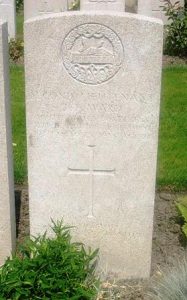
World War Two, 1939-1945
William Longman, Civilian. William was born on 6 October 1908, the son of Charles and Elizabeth Longman, of Sarn, Churchstoke. He worked as a labourer prior to the war, then volunteered to become a firewatcher in Birmingham. William married Winifred Hill at Birmingham in 1941, and the couple lived at 118, Station Road, Handsworth. Birmingham was an important industrial centre, so was a priority target for the German Luftwaffe. There was heavy bombing from August to December 1940, followed by large bombing raids in March, April and May 1941. William was killed at Rookery Road, Handsworth during one of the last minor air raids on Birmingham. He was 34-years-old. William is not commemorated on the Churchstoke war memorial.
William Arthur Thomas, Gunner, 908262, Royal Artillery. William was the son of Richard Thomas and Catherine Sarah Beatrice Thomas (nee Lloyd), of Hyssington. He enlisted into the Royal Artillery and was posted to 51 Medium Regiment, Royal Artillery. The regiment was a North Midland (Staffordshire) based Territorial Army unit, which trained at Stone, Staffordshire, and Bradford-on-Avon before embarking for France with the BEF in February 1940, equipped with the 6-inch howitzer. The regiment took over a section of the Maginot Line, attached to the 51st (Highland) Division, and saw heavy fighting before being forced to withdraw to Le Havre, where the survivors were evacuated. During the period of the Battle of Britain the regiment manned coastal defence guns in Western Command, and then in December 1940 it assembled at Ellesmere for re-equipping and retraining on the new 5.5-inch gun. William died in Shrewsbury on 31 March 1941, aged 23. His body was brought home for burial in St. Etheldreda’s Churchyard, Hyssington.
Frank Richard Wellings, Pilot Officer, J/4890, Royal Canadian Air Force. Frank was born at Wolverhampton on 17 February 1913, the son of Isaac Edward Wellings and Edith Wellings (née Williams). His mother was from Churchstoke, and the family later moved to Pentrenant Hall, Churchstoke. Frank was educated at Wolverhampton and then at the East Anglian School at Bury St. Edmunds, before gaining a B.Sc. (Hons) in Petroleum Engineering at Birmingham University. He then worked for Foster Wheeler in London before gaining a position for Apex Oilfields in Trinidad in 1935, and left his job to enlist in Canada into the Royal Canadian Air Force on 15 July 1940, stating his desire to train as a pilot. Frank had around 30 hours experience on flying a Tiger Moth in Trinidad, and after gaining his pilots wings at No. 5 Flying Training School at Brantford, Ontario, gained a commission as a Pilot Officer on 20 March 1941. He was then posted to England, embarking at Halifax on 9 July 1941, to join 209 Squadron, RAF. The squadron was attached to Coastal Command, and was based at RAF Pembroke Dock, equipped with the Consolidated Catalina, carrying out anti-submarine and convoy escort duties. At 04.45 on 14 December 1941, Frank took off from Pembroke Dock aboard Consolidated Catalina AH 530, which was to carry out a sweep of the Bay of Biscay. As the Catalina was gaining height, it clipped a drifter off Weare Point, and crashed into the sea, killing nine of her crew of eleven men. Frank was 28-years-old when he was killed that day. His body was never recovered, so he is commemorated on the Runnymede Memorial, Surrey. Frank is not commemorated on the Churchstoke war memorial.
Benjamin John Williams, Sergeant, 942422, Royal Air Force Volunteer Reserve. Benjamin was born at Churchstoke on 15 April 1917, the son of Benjamin Edward Williams and Hilda Daisy Emma Williams (nee Andrews). His father was the schoolmaster at Churchstoke for many years prior to the war, but after retiring moved with his wife to Bournemouth. Benjamin enlisted into the Royal Air Force Volunteer Reserve, and trained as a Wireless Operator before being posted to 70 Squadron, RAF. In August 1939 the Squadron was posted to Egypt, where it converted to Vickers Wellingtons, and began operations over the Western Desert. On 13 December 1941, Benjamin was flying aboard Wellington Ic, Serial X9686, which was being flown by Pilot Officer Kenneth Kitto, and was taking part in an operation by the Squadron to attack Motor Transport in the Derna Area. The Wellington was hit by anti-aircraft fire during the attack, and crashed near Martuba, killing all six of her crew, including Benjamin. Benjamin was 24-years-old when he was killed that day, and is buried alongside his fellow crewmen in Knightsbridge War Cemetery, Acroma, Libya.
Frank Richard Williams, Private, M/12909, Indian and Malay Corps. Frank had emigrated to South Africa at some time prior to the war, and enlisted into the South African Forces. When the Allies launched their campaign into Ethiopia early in the war, Frank was posted to the Indian and Malay Corps, and sent to Kenya. He died there on 29 May 1941, and is buried in Nanyuki War Cemetery, Kenya. (This is the only man matching the name on the Churchstoke war memorial, although no links to the area can presently be traced).